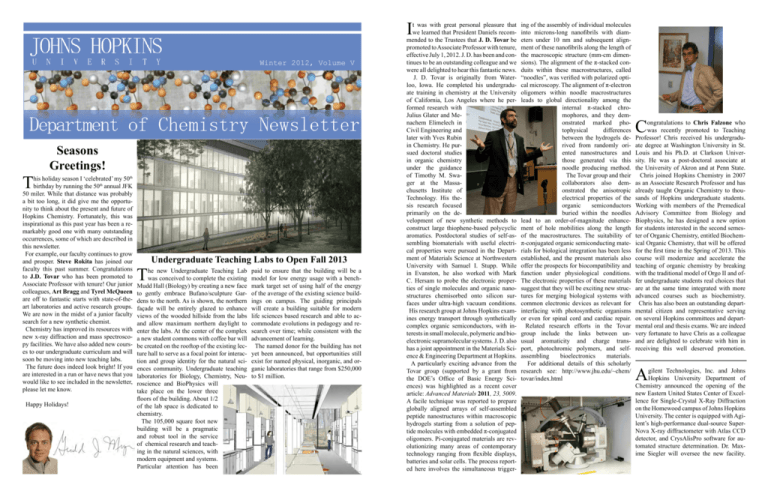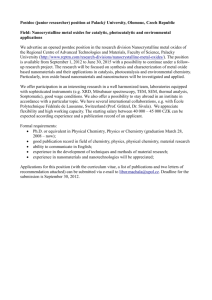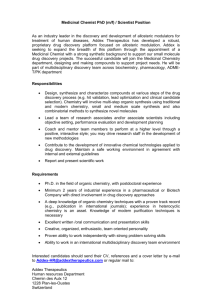Seasons Greetings! - JHU Department of Chemistry
advertisement

I Winter 2012, Volume V Seasons Greetings! his holiday season I ‘celebrated’ my 50th birthday by running the 50th annual JFK 50 miler. While that distance was probably a bit too long, it did give me the opportunity to think about the present and future of Hopkins Chemistry. Fortunately, this was inspirational as this past year has been a remarkably good one with many outstanding occurrences, some of which are described in this newsletter. For example, our faculty continues to grow and prosper. Steve Rokita has joined our faculty this past summer. Congratulations to J.D. Tovar who has been promoted to Associate Professor with tenure! Our junior colleagues, Art Bragg and Tyrel McQueen are off to fantastic starts with state-of-theart laboratories and active research groups. We are now in the midst of a junior faculty search for a new synthetic chemist. Chemistry has improved its resources with new x-ray diffraction and mass spectroscopy facilities. We have also added new courses to our undergraduate curriculum and will soon be moving into new teaching labs. The future does indeed look bright! If you are interested in a run or have news that you would like to see included in the newsletter, please let me know. T Happy Holidays! Undergraduate Teaching Labs to Open Fall 2013 T he new Undergraduate Teaching Lab was conceived to complete the existing Mudd Hall (Biology) by creating a new face to gently embrace Bufano/sculpture Gardens to the north. As is shown, the northern façade will be entirely glazed to enhance views of the wooded hillside from the labs and allow maximum northern daylight to enter the labs. At the center of the complex a new student commons with coffee bar will be created on the rooftop of the existing lecture hall to serve as a focal point for interaction and group identity for the natural sciences community. Undergraduate teaching laboratories for Biology, Chemistry, Neuroscience and BioPhysics will take place on the lower three floors of the building. About 1/2 of the lab space is dedicated to chemistry. The 105,000 square foot new building will be a pragmatic and robust tool in the service of chemical research and teaching in the natural sciences, with modern equipment and systems. Particular attention has been paid to ensure that the building will be a model for low energy usage with a benchmark target set of using half of the energy of the average of the existing science buildings on campus. The guiding principals will create a building suitable for modern life sciences based research and able to accommodate evolutions in pedagogy and research over time; while consistent with the advancement of learning. The named donor for the building has not yet been announced, but opportunities still exist for named physical, inorganic, and organic laboratories that range from $250,000 to $1 million. t was with great personal pleasure that we learned that President Daniels recommended to the Trustees that J. D. Tovar be promoted to Associate Professor with tenure, effective July 1, 2012. J. D. has been and continues to be an outstanding colleague and we were all delighted to hear this fantastic news. J. D. Tovar is originally from Waterloo, Iowa. He completed his undergraduate training in chemistry at the University of California, Los Angeles where he performed research with Julius Glater and Menachem Elimelech in Civil Engineering and later with Yves Rubin in Chemistry. He pursued doctoral studies in organic chemistry under the guidance of Timothy M. Swager at the Massachusetts Institute of Technology. His thesis research focused primarily on the development of new synthetic methods to construct large thiophene-based polycyclic aromatics. Postdoctoral studies of self-assembling biomaterials with useful electrical properties were pursued in the Department of Materials Science at Northwestern University with Samuel I. Stupp. While in Evanston, he also worked with Mark C. Hersam to probe the electronic properties of single molecules and organic nanostructures chemisorbed onto silicon surfaces under ultra-high vacuum conditions. His research group at Johns Hopkins examines energy transport through synthetically complex organic semiconductors, with interests in small molecule, polymeric and bioelectronic supramolecular systems. J. D. also has a joint appointment in the Materials Science & Engineering Department at Hopkins. A particularly exciting advance from the Tovar group (supported by a grant from the DOE’s Office of Basic Energy Sciences) was highlighted as a recent cover article: Advanced Materials 2011, 23, 5009. A facile technique was reported to prepare globally aligned arrays of self-assembled peptide nanostructures within macroscopic hydrogels starting from a solution of peptide molecules with embedded π-conjugated oligomers. Pi-conjugated materials are revolutionizing many areas of contemporary technology ranging from flexible displays, batteries and solar cells. The process reported here involves the simultaneous trigger- ing of the assembly of individual molecules into microns-long nanofibrils with diameters under 10 nm and subsequent alignment of these nanofibrils along the length of the macroscopic structure (mm-cm dimensions). The alignment of the π-stacked conduits within these macrostructures, called “noodles”, was verified with polarized optical microscopy. The alignment of π-electron oligomers within noodle macrostructures leads to global directionality among the internal π-stacked chromophores, and they demonstrated marked photophysical differences between the hydrogels derived from randomly oriented nanostructures and those generated via this noodle producing method. The Tovar group and their collaborators also demonstrated the anisotropic electrical properties of the organic semiconductors buried within the noodles lead to an order-of-magnitude enhancement of hole mobilities along the length of the macrostructures. The suitability of π-conjugated organic semiconducting materials for biological integration has been less established, and the present materials also offer the prospects for biocompatibility and function under physiological conditions. The electronic properties of these materials suggest that they will be exciting new structures for merging biological systems with common electronic devices as relevant for interfacing with photosynthetic organisms or even for spinal cord and cardiac repair. Related research efforts in the Tovar group include the links between unusual aromaticity and charge transport, photochromic polymers, and selfassembling bioelectronics materials. For additional details of this scholarly research see: http://www.jhu.edu/~chem/ tovar/index.html C ongratulations to Chris Falzone who was recently promoted to Teaching Professor! Chris received his undergraduate degree at Washington University in St. Louis and his Ph.D. at Clarkson University. He was a post-doctoral associate at the University of Akron and at Penn State. Chris joined Hopkins Chemistry in 2007 as an Associate Research Professor and has already taught Organic Chemistry to thousands of Hopkins undergraduate students. Working with members of the Premedical Advisory Committee from Biology and Biophysics, he has designed a new option for students interested in the second semester of Organic Chemistry, entitled Biochemical Organic Chemistry, that will be offered for the first time in the Spring of 2013. This course will modernize and accelerate the teaching of organic chemistry by breaking with the traditional model of Orgo II and offer undergraduate students real choices that are at the same time integrated with more advanced courses such as biochemistry. Chris has also been an outstanding departmental citizen and representative serving on several Hopkins committees and departmental oral and thesis exams. We are indeed very fortunate to have Chris as a colleague and are delighted to celebrate with him in receiving this well deserved promotion. A gilent Technologies, Inc. and Johns Hopkins University Department of Chemistry announced the opening of the new Eastern United States Center of Excellence for Single-Crystal X-Ray Diffraction on the Homewood campus of Johns Hopkins University. The center is equipped with Agilent’s high-performance dual-source SuperNova X-ray diffractometer with Atlas CCD detector, and CrysAlisPro software for automated structure determination. Dr. Maxime Siegler will oversee the new facility. S teve Rokita joined our faculty in June of 2012. Steve received his undergraduate degree in chemistry at UC-Berkeley and completed his Ph.D. with Chris Walsh at MIT. Steve completed postdoctoral work at Rockefeller University with Tom Kaiser and held faculty positions at SUNY-Stonybrook and the University of Maryland College Park before joining us here at Hopkins. Professor Rokita’s research program is united by a common interest in describing the structure and activity of biological macromolecules through their essential chemical reactivity. The methods of organic synthesis, physical organic chemistry, protein and nucleic acid chemistry, biochemistry and molecular biology are applied to questions on enzyme catalysis and nucleic acid modification. Current research efforts in the Rokita labs include enzymatic dehalogenation, DNA photochemistry and electron transfer. A long standing collaboration exists between the Rokita and Karlin laboratories on metal dependent recognition and oxidation of nucleic acid polymers. Steve will contribute to the teaching of organic and biochemistry courses and laboratories. He is also an active participant in the Chemistry-Biology Interface (CBI) program. For more details see: http://www. chemistry.jhu.edu/Rokita/biography.html T yrel McQueen received his B.S. in Chemistry at Harvey Mudd College, followed by a M.A. and Ph.D. at Princeton with Bob Cava. After postdoctoral studies with Dan Nocera at MIT, Tyrel joined our faculty in the Fall of 2010 with a joint appointment in the Department of Physics and Astronomy. He is also a principal investigator in the DoE supported Institute for Quantum Matter at Hopkins and has an active research group with laboratories in the Bloomberg Center of Physics and Astronomy. The McQueen laboratory is focused on the discovery of new phenomena through the design and synthesis of new materials; more specifically, they aim to achieve the next generation of materials revolutions by combining the development of new synthetic techniques with advances in measurement and analysis methods to discover, design, and control materials with exotic electronic states of matter. Specific interests include: (i) Discovering novel materials with favorable physical (electrical, magnetic, optical) properties; (ii) Elucidating the structureproperty relationships in these new compounds, especially with regard to strong electron correlations and their influence on the electrical, magnetic, and optical properties through coupling of charge, orbital, and spin degrees of freedom; and (iii) Pushing our understanding of how to design better materials with specific functions. An exciting recent advance from the McQueen laboratory was published in Nature Materials, vol. 11, pg. 493 (2012), and highlighted in Science Magazine. They reported the discovery of a new class of materials that provide unprecedented access to, and Tyrel was recently honored with a 2012 David and Lucille Packard fellowship for Science and Engineering. To my knowledge, this is the first time that a faculty member in our department has ever received this prestigious fellowship. The funding will enable Tyrel and his research group to explore creative high risk experiments. It will be exciting to see what fascinating new science emerges from this fellowship. Details of current research areas can be found at: http://occamy.chemistry.jhu.edu/ Recent Gifts to the Department The Department of Chemistry thanks you for your generous support! John E. Basinski Randolph Barton, Jr. Dennis P. Carroll Marc J. Chapdelaine Anthony L. Dent Joseph B. DiGiorgio Glenn E. Fulmer Thomas E. Gompf Todd L. Graybill Charles P. Kulier Kunichi Matsushita Foil A. Miller O riginally from Michigan, Art Bragg majored in chemistry and physics as an undergraduate at Albion College. He studied the ultrafast dynamics of size-selected, molecular and cluster anions as a graduate student with Dan Neumark (UC Berkeley), and went on to investigate molecular-level details of solvation dynamics in bulk solutions as a post-doc with Ben Schwartz (UCLA). Art joined Chemistry at John Hopkins in the fall of 2010 and represents our first faculty with expertise in ultrafast spectroscopic methods (time-resolved on time scales down to 10-14 seconds). He now has an active team of graduate researchers with laser and wet laboratories in Remsen Hall. control over, emergent electronic behavior Dr. Bragg and his research group are intervia the tunability of molecular magnetism -- ested in the spectroscopy and ultrafast dymore specifically, magnetism of metal oxide clusters. Geometrically frustrated antiferromagnets are materials in which unpaired electrons are placed on lattices in which it is impossible to simultaneously satisfy all magnetic interactions between electrons, such as the triangular lattice. The result is a large degeneracy of electronic states that has been predicted to result in the emergence of namics of poly-conjugated molecules that a number of new states of matter, such as the are used increasingly in material applica‘spin-liquid’ state, in which there is quantum tions. One of his group’s research directions entanglement over macroscopic distances. uses a combination of spectroscopic techThe McQueen laboratory discovered that niques to interrogate the structural properby localizing the unpaired, magnetic elec- ties and dynamics of excited and charged trons on small Mo3O13 clusters rather than states localized on π-conjugated polymers. individual ions (e.g. Cu2+), first-order Jahn– These polymers are common building Teller instabilities and orbital ordering are blocks for organic-based solar cells, and a prevented, ensuring the large degeneracy of goal of the Bragg Lab’s work is to characterstates persists to very low temperatures, at ize how relationships between structure of least 0.05 K. This allows for a non-trivial these states and their dynamics underlie mamagnetic state to form, most probably one terial function. An example of this work was based on the formation of singlet pairs, a published recently in J. Phys. Chem. Lett. so-called condensed valence-bond ground 2012, 3, 1321, where Bragg and his students state. These results link magnetism on metal reported the use of time-resolved resonantclusters to geometric magnetic frustration in Raman spectroscopy to investigate the picoextended solids, allowing the unparalleled second conformational relaxation of regiochemical control and tunability familiar to regular poly(3-hexylthiophene) in solution chemists to be applied in the search for col- after photoexcitation. This work reported lective, emergent electronic states of matter. spectra of vibrations within excited polymer segments and also used variations in spectral dynamics to identify features that are likely to be associated with structural motifs that confine polymer excitations within specific regions of the extended polymer framework. Current work continues to decipher spectral correlations with excited-state structure of polymers and oligomers in solution and is also examining the characteristics of transient states generated in aggregated polymers following light absorption. All of this work aims to elucidate fundamental mechanisms by which absorbed solar energy is transferred within organic materials. Other research in the Bragg Lab uses ultrafast time-resolved absorption to investigate inter- and intramolecular energy-transfer pathways that underlie photo-cyclic ringclosure reactions of conjugated molecules. A fundamental goal of this work is to examine the details of ultrafast non-adiabatic relaxation processes that direct ring closure from photo-excited molecular states and to determine how these processes are influenced by variations in chemical environment. A second objective is to flesh out dynamical considerations that should be heeded in order to utilize these processes effectively in synthetic schemes for making useful conjugated materials (e.g. graphene-like ribbons), since reactions involving relatively complex reactants will be influenced by somewhat different structural constraints for any given ring-closure step. Art has also played a key role in revising the Physical Chemistry Lab course and has developed an entirely new graduate course in time-dependent spectroscopy. For additional details of the scholarly advances in the Bragg research group, see: http://www.jhu.edu/chem/bragg/ James E. Oliver M. Jane Phillips Gerald J. Putterman Ronald E. Pyle Eleanor A. Samworth Roosevelt Shaw Carlyle B. Storm Yuji Takahata Joseph F. Testa Kelly A. Van Houten Robert T. Wang Corporate Gifts to the Department The Department of Chemistry thanks the following corporate donors and their associated alumni! Fidelity Charitable Fund (Morris T. Reagan) Merck Co. Foundation (Terence G. Hamill) Pfizer Foundation (Charles P. Kulier) Strategic Scientific, Inc. (John H. Wieser) Class of 2012 Graduates Sesime Akoto Timothy Bowman Stephanie Earle Christine Hiemstra1,2,3 Jeffrey Jou4 Moon Young Lee3,5,6,7,8 Vasilios Mavrophilipos2 Matthew S. Morris4 David Park2 Blake Platt2 Beshoy Sidhom Soraya Simon Adam Stevens Elisabet Tassis ACS undergrad affiliate General Honors 3 Dean’s List 4 Kilpatrick Scholar 1 5 2 6 NSF Fellowship ACS award 7 Golden Key 8 Provost’s Award 2012 PhD Degrees Awarded Jing Chen (Bowen Lab), University of Maryland College Park Kevin Cho (Goldberg Lab), Postdoc at Yonsei University, Korea Meredith Cline (Toscano Lab), Lecturer at Miami University Jeanne Davidsen (Townsend Lab), interviewing Jeremy Erb (Lectka Lab), Postdoc at Ohio State Byron Farnum (Meyer Lab), Postdoc at UNC Chapel Hill Alicia Fraind (Tovar Lab), Postdoc at University of Virginia Douglas Genna (Posner Lab), Postdoc at University of Michigan Yunbo Jiang (Goldberg Lab), Postdoc at Oregon Health & Science University Patrik Johansson (Meyer Lab), Postdoc at Chalmers University, Sweden Pannee Leeladee (Goldberg Lab), Faculty at Chulalongkorn Univ., Thailand Katharine Prokop (Goldberg Lab), Postdoc at Monell Chemical Senses Center Art Sutton (Toscano Lab), SC Johnson Haopeng Wang (Bowen Lab), Postdoc at Georgetown University Chemistry Department SWEEPS Intramural Sports Congratulations to all our players!






